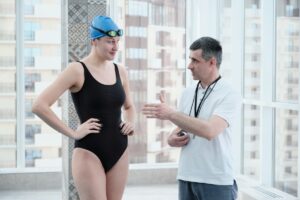
Competitive swimmers live and breathe their sport! This is why they train twice a day, six days a week. However, intensive training is not the only thing that makes swimming such a hard sport!
Swimming, one of the hardest sports?
Swimming? A hard sport? Not everyone would think that right away. In the sports world, everyone thinks their sport is the most difficult. Each sport has its own challenges and swimming comes with its own. This is why it’s one of the hardest sports compared to its dryland counterparts.
1. Water Resistance
Water is a component of swimming that makes it unique. It causes resistance which makes the sport more demanding on your muscles putting more strain on your body. Think of swimming as biking or running with a parachute behind you. Air is 784 times less dense than water at sea level. This means there is more drag while swimming. Drag is a type of friction that slows down moving objects based on how much fluid surrounds them. There’s more resistance when you swim faster.
Water resistance makes it feels like you are swimming against a current. That’s because you quite literally are. There are three types of resistance:
- Frontal Resistance: This happens when a swimmer puts more of their body underwater than necessary. Rolling the body to the side and staying above the water can counter this.
- Skin Friction: This is the drag created when a swimmer’s body and swimsuits pass through the water. Shaving body hair and wearing racing suits with ridges on them can combat this type of resistance.
- Eddy Resistance: A vortex or whirlpool will form at the surface of the water when performing a front crawl. To avoid dealing with this type of resistance, practice and perform this stroke correctly.
There are ways to push back against each type of resistance. However, it takes time to master each of them which gives swimming a whole other challenge.
2. Breathing
Breathing is something that comes naturally to us when we are on land. While swimming, you need to control your breath to increase your oxygen supply to avoid drowning. Since you have to exhale with your face in the water, your lungs are empty and ready to accept a breath. You need to gain a rhythm and exhale through your nose and mouth to complete the breath. This leaves no room for pausing!
Breathing is something simple to do on land, but it’s not so easy when your head is going in and out of the water. The United States Masters Swimming coaches its swimmers to breathe using the following techniques:
- Alternate Breathing: Take a breath for every third arm movement during a stroke. Some benefits of this method are improving your stroke and switching the side you breathe on to see other competitors.
- Breathing with Economy: When swimming longer distances, it’s not safe to hold your breath the whole time. Instead work on a inhale and exhale rhythm that allows you to take breaths that are spaced out.
- Blow Away Panic and Keep Your Speed: Take a larger breath when you are getting worn down. This will blow out the CO2 reflex that would regularly slow you down and let you keep your pace.
Each of these techniques is used in different situations. It’s a matter of understanding when to use which one. Working with a professional coach can help you become a better swimmer.
3. Technique
The technique is of utmost importance in the water because it keeps you from drowning. Swimming 50 metres can be a struggle for some people. It’s not because they aren’t fit, but because they are missing the proper technique. Swimming takes time and doing drills and practicing are the best ways to get better.
Four main swimming strokes are used in swimming at the competitive level. Each one is difficult in its own way. Below are the strokes and how to perform them correctly:
- Backstroke: Lie on your back while moving your arms in a circular motion and flutter kicking your legs. As the states, you will be pushing yourself backwards through the water.
- Breaststroke: Float on your stomach and push yourself forward by moving your arms in a semi-circular motion. Bend your legs and start kicking backwards. This is usually the first stroke people learn because of its simplicity.
- Butterfly: Hold your arms above your head and push them downwards into the water. Put your legs together behind you and kick them in and out of the water like a dolphin. This is the hardest stroke to learn.
- Freestyle: Lie on your stomach like the breaststroke. Then flutter your arms and legs around in a motion reminiscent of a windmill. This is ideal for exercise and swimming to test your endurance.
After all, is said and done, how will you know if you’re doing a stroke correctly? Some lessons with a certified private instructor can help!
4. Fear
Fear is what holds many back from trying new things. In swimming, fearful people panic and thus increase their chances of drowning. Sports that have dangers are generally considered more difficult. Swimming, scuba, snorkelling, skydiving and many more sports can be considered deadly. With proper technique and practice, fear can be conquered!
A fear of swimming can stem from a variety of circumstances. Here are a few reasons why people are scared of the water:
- Past Negative Experiences: An injury or traumatic event can make all the difference when it comes to getting back in the pool. For example, almost drowning can make one hesitant to go swimming again.
- Lack of Swimming Knowledge: Not everyone learns how to swim at a young age and this makes it harder to take the plunge later in life. Social stigmas are some of the biggest culprits in this situation.
- Self-Doubt: Confidence is a big part of being comfortable in the water. Those that lack it will not want to swim regardless of knowing how to. Believing in yourself is key to mastering any skill.
- Aquaphobia: In scientific terms, this is what it means to be clinically diagnosed with fear of the water. This can be helped over time by finding ways to cope with anxiety by seeing a medical professional.
It’s perfectly normal for people to have a fear of swimming or the water. The best way to conquer your fears is to take them head-on by finding techniques to ease anxiety and or getting professional help.



